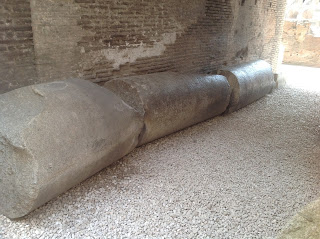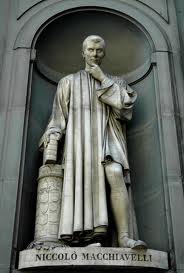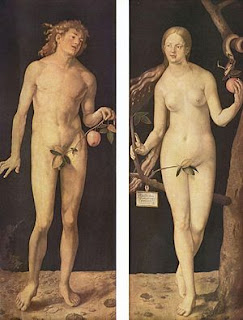Since going to Rome was going to be an all day excursion, we got room service at 6:30 AM. We asked for more food in order to make a light lunch for our noon picnic in Rome. I had gotten apples oranges and bananas the previous day, and I added this to our meal which I placed in my back pack.
After breakfast went down to the Liquid Lounge. As usual the lounge was full of people waiting for their number to be called. We picked up our tickets and our paste-on number "19" at the reception table and took a seat. There were over 20 excursions, so we knew we would be waiting a while. Finally our number was called, and we went out to find our bus. There were only a few buses left and found ours near the end of the parking lot with the number 19. Like the trip to Florence, we were going to have two guides one for the bus and one for sight seeing in Rome. The bus guide's name was Renata. She was a husky young lady with a baritone voice who spoke with a heavy accent which always ended her words with an extra syllable..."nnd." It was a little getting used to at first, but soon enough the ear seems to adjust to this mode of communication.
As Americans who are accustomed to instant gratification, we make it known that if something is not going well. In this case Renata was babbling along, but she wasn't talking into the mic. Almost in unison, people on the bus yelled, "We can't hear you!" Renata turned around with a surprised expression as if we had interrupted her thoughts, and fiddled about with her mic bringing it up to her mouth and asked, "You..nd can hear..nd me now..nd?" and everyone yelled, "YES!" So she went back to her history lecture where she left off...
I got a few words of her previous lecture..."Romulus..nd Remus..nd..." I figured she began with the founding myth of Rome. According to historians Rome was founded by Romulus in 735 BC. But what about the "suckling wolf" you ask???
The legend has it that Rhea Silvia conceived twins by the god Mars against her brother's wishes for her to become a Vestal Virgin. When she gave birth, she left her babies in a large jar to die in the r Tiber River. Somehow they were carried down the river to safety. They were found by a she-wolf who lost her pups and adopted them while her friend the woodpecker fed them grubs. After a while a shepherd and his wife find them and raise them as their own. They name them Romulus and Remus and as they grow older they become leaders if their village. They create a new city on the Palatine Hill. Remus has a falling out with Romulus and since things were settled in a blood thirsty way in those days, Romulus kills Remus and names his new city Rome after himself!
Romulus invited all classes of men including slaves and freemen to become citizens of his state. Noticing that his fledgling city had few women to populate his realm, he led the men to the hills and invaded Sabine and stole their women. The Sabine king, Tatius, retaliated and counter attacked Rome, but the women stepped in and convinced Tatius and Romulus to reconcile and rule jointly sparing more blood shed. Romulus selected 100 men of his choosing to form a Roman senate as an advisory council. He grouped these hundred into three parts: Romans, Sabines and Etruscans. Each would get one vote collectively. Then he grouped the populace into thirty "Curiae" named after the thirty of the Sabine women who had intervened to end the war between Romulus and Tatius. The "curie" formed the voting units in the Roman assembly. By voting everyone got their ideas known, and they all owned part of the decision. This was very innovative thinking for its time unless they knew about the Greeks. The tribes stayed together when prosperity abounded and as time went on, more tribes were acquired and Rome continued to prosper after the rule of seven kings.
Renata was now speaking about the Etruscans, a migratory peoples from the Near East who settled in Italy. They were known for their mining quest and metal work with copper and iron. Rome was a smaller state and as the Etruscans merged with Rome, their knowledge in metallurgy added to the prosperity of future Roman conquests. The Etruscans built their cities at the top of hills and dug ditches all around like a moats. This offered great protection for those who lived above. The seven hills of Rome became strategic in this regard. They were also great engineers depicted by the bridges they built across the Tiber River.
While the patter of history continued, I took a look out the window to see that it was harvest time, and all the wheat was being rolled up into bales just like in the American mid -west.
We had been driving for at least an hour and the history continued! So by this time the Gauls had invaded Rome. It was 390 BC. The Gauls occupied and sacked Rome looting what ever they could including any historical accounts of that period, that's why some of what we just learned may have been made up! After the Gauls left to go back to what is now France, the humiliated Romans knew they had to build a stronger belt of walls all around the seven hills. They called this barrier, the Servian Wall. They then fortified and trained their army. With its machine like army, they began to conquer settlements to the north, east, and south. By 290 BC they controlled most of the Italian peninsula. After these conquests they began building great Roman roads to unify all the conquered peoples and gave them all Roman citizenship. People flocked to Rome and with the abundance of people, the Romans built the first completely underground aqueduct to bring drinking water to Rome.
Rome now wanted to expand to the island of Sicily, but it was under the influence of Carthage which was originally a Phoenecian port in north Africa what is not Tunisia.
 |
| Sicily is up for grabs! (Are these guys puny or what!) |
 |
| The Roman army was well disciplined! |
 |
| Elephants transported the water on special barges. |
 |
| Hannibal has a great vantage view on top of an elephant! |
 |
| Throwing a javelin from the houdah. |
 |
| African elephants in the Alps! |
The Roman commanders decided they would strike Carthage to put an end to the war. The Romans sailed to Carthage to launch offensive on their soil. By now they had ways to fight against elephant warfare. When they Roman lines were attancked by charging elephants, they simply moved the lines separating to let the charging elephants go by. Other times they would hurdle fire bombs to scare the elephants or attack them with carts filled with javalin spears. In some cases the frightened animals ran behind their lines and crushed their own soldiers.
 |
| The well disciplined Roman army flanked away to let the elephants pass. |
At the end of the Punic wars, the war elephants were again brought to Europe by the Romans. Julius Ceasar used them in his invasion of Britain in 43AD. The war elephants gave the archers a great advantage being able to attack from the high position in the houdah. Just the sight of the large beast must have been quite a frightful experience to the native people of Britain.
After these wars Rome flourished again with the abundance of workers. Buildings were being erected such as the Circus Flaminius, Roman Forum, great Basilicas. These ancient Roman basilicas were great halls used for administration of justice and transaction of public and private business. Also great buildings were built to store grain and other staple foods which made food abundant in the city. To add drinking and bathing water, two new aqueducts were built: Aqua Marcia and Aqua Tepula. Rome was the place to be.
Dominance of the Mediterranean also brought supremacy in the East with the conquest of the kingdoms that were part of Alexander the Great's empire. Contact with the east opened up new ideas in architecture. The use of the arch transformed the square cut concept of the Greek style into concept of curves. Using rare marbles from the East also embellished their architecture with marble columns. Dull little houses made of wood were replaced by multi-storied brick buildings, palaces and temples. Narrow winding streets made way for broad thoroughfares.
 |
| Julius Caesar |
By the time Julius Caesar conquered Gaul, Rome's lands increased until they formed a vast empire that covered the major part of the ancient world. It was hard to govern such a large area, however, and though Julius Caesar tried to do it by becoming a dictator, this wasn't the Roman way and he was assassinated. The Senate tried to bring back the republic, but it could not and eventually Augustus rose to power. Rome became the largest city in the Mediterranean with approximately 2 million people.
 |
| Augustus |
This was the height of Rome's glory and then it was down hill from there.
Now we arrived at the outskirts of Rome. We see by the ruins that it is left as it was without being rebuilt. We will be able to see its greatness by the ruins that survived the ages. These will give us a clue to what life was like in the first century when Rome ruled the known world.
On the outside of Rome, we drove to a street in our modern age. It was full of little cars and apartment buildings that are part of our world today. Lines of electric wires lace the high barriers waiting for the street cars to come.
As we continue into the center of town we now see some of the ruins left in the city.
 |
| Part of an acquaduct still stands |
After our driver parked our bus, Renata gave us our walkie-talkies so that we will be well equipped to listen to our guide. We were introduced to Angela our guide for the rest of our walking tour. Renata was in charge of keeping us together and to make sure everyone was accounted for.
Angela was introduced as an archaeologist with a PhD. She spoke with a matter of fact kind of voice that implied, "Don't question me, as I know what I am talking about..." So we humbly followed her to the Colosseum.
 |
| Colosseum designs with arches known as the Flavian Amphitheatre |
We had to watch our steps over the paved stones and bricks as Angela set a fast pace around to the front entrance.
As we came around the building we could see the construction of the arch with the key stone in the top center. We also saw the holes all over the building. Angela said that they were holes made after vandals extracted iron that they used to make weapons or tools.
We came to the entrance handed our tickets and walked in with a multitude of tourist .
Angela pointed out that the arched roofs were covered to prevent loose stone from falling on tourists.
We stopped at the entrance wall where Angela explained to us the exact dimentions for assemembling the bricks. The width size of the brick was measured by two fingers. As can be seen they are all identical size throughout the wall.
She also pointed out that the space between the bricks on this particular wall was one finger in width.
Along the floor lay several examples of marble columns that must have looked impressive in ancient times.
A few more pillars pieces lay by another alcove.
Behind some restraining bars, we noticed some steps that lead to higher seats. They were very steep and close together and absolutely no wheel chair access.
Angela used her lollipop to point out one of the pieces of iron that was used to hold the blocks together.
She also had us look at the arch and find the key stone in the center. The building of arches was a result of going to the Middle East and observing Arabic buildings. This knowledge transformed Roman architecture in the early centuries AD.
Some tops of columns were saved to show he beauty of their construction.This is the top of a Corinthian column.
The Italians are proud of the construction of their buildings. The explanation is written in both English and Italian.
We finally step into the seating area and observe the viewing space below.
 |
| John poses inside the Colosseum |
 |
| This level is for the privilege class and the Vestal Virgins sit. |
The Emperor Titus inaugurated the building of the Colosseum in 80 AD. The construction took eight years. The external architecture consisted of three storeys of arches (80 arches per storey). The archways had Doric semi columns on the first floor, Ionic on the second floor and Corinthian on the third. Thousands of blocks of travertine, 3,5000,000 cubic feet, were transported from the quarries at Tivoli for its construction. An earthquake-proof construction technique was introduced by firmly joining the blocks securely together. The technique consisted in placing iron clamps inside the stone blocks for a total weight of 300 tons of metal. The housing for the clamps is visible in blocks knocked down by other devastation. The holes on the outside and inside of the building were made during the Middle Ages in order to remove the metal clamps for other uses.
The auditorium consisted of tiers of seats, which climbed from the oval of the arena up to the balconies. It held 50.000 spectators. So many of the people could enter in a small amount of time thanks to 76 entryways, which were consecutively numbered. People would bring their ticket to the door number stamped on their ticket which was then clipped. Four main entryways did not have numbers. These were reserved for the dignitaries. Bathrooms and drinking fountains were also installed in various places in the ground level. Thee were at least 50 drinking fountains along the circumference of the building.
Today looking at the colosseum you have to use your imagination to see how spectacular the events were for the people of Rome. The main event were the gladiator spectacles that can be attributed to the Etruscans. The spectacles were organized and regulated by the Leges Gladiatores. To recruit combatants, the editor(game organizer) went to the owner (lanista) of the gladiator troops who were criminals condemned to death, slaves, and free men who wanted to get rich quickly. Angela pointed to the barracks which were linked directly to the colosseum by an underground tunnel. There were sixteen types of gladiators: Galli, Murlmillones, Oplomachi, Simnites, and the Secutores. These fuought with heavy equipment. the Thraeces fought with light arms, and the Retiarii fought with nets and tridents. The Eques fought on horse back and were held in high esteem. The gladiators and their supporters gathered on the eve of combat for a great banquet (cena libra).
Combat began with the sound of music. The audience participated with bloodthirsty enthusiams. There were two types of combat: The sine missione in which one or both died. and the missio if one of the two contenders was felled or wounded, he laid down his sword and raised his index finger of his left hand in order to ask the sponsor for grace. Angela showed us her thumb up to live, down to die. She also said that two fingers across the neck would indicate death.
Gladiators would also have to fight wild animals in the arena. This type of combat took place in the morning. It was very popular and gave rise to great enthusiasm in the Roman people because of the great variety of animals involved such as: lions, tigers, panthers, leopards, water buffalo, bears, even elephants. the number of animals to hunt and kill grew with time and after the conquest of new territories. Even exotic animals were added such as: crocodiles, hippos and rhinos from Egypt.
The animals were kept below in cages. When it was time for them to fight, they were goaded out of their cages and made to enter rudimentary lifts activated by counterweights. Then they ran up into the open air by means of a wooden ramp where the gladiators or hunters were waiting. A strong wire net around the arena protected the spectators.
The martyr of Christians in the Colosseum is still a matter of debate. Despite of written testimony it is logical to assume that the martyrdom of Christians was also carried out. As time went on when Christianity became the core of life in Rome plaques and crosses to commemorate martyrdon were placed in the Colosseum.
 |
| Painting by Jean Leon Gerome of Christian martyrs |
 |
| Pope Benedict XIV consecrated the arena to the Christian martyrs in 1740 |
We leave the Colosseum and follow Angela outside to the Arch of Contsantine, the Temple of Venus on the right and the Arch of Titus at the end of the street.
We approach the Arch of Constanine decreed by the Senate and the People of Rome after the General's victory over the Emperor Maxentius in 312AD. It is the largest preserved of the arches in Rome.
We then walked towards the Tiber River.
We continue to walk along the bridge heading for the Vatican. We would take a break for lunch and the spend the rest of the afternoon at St. Peter's Basilica!














































 m
m






















 r
r







